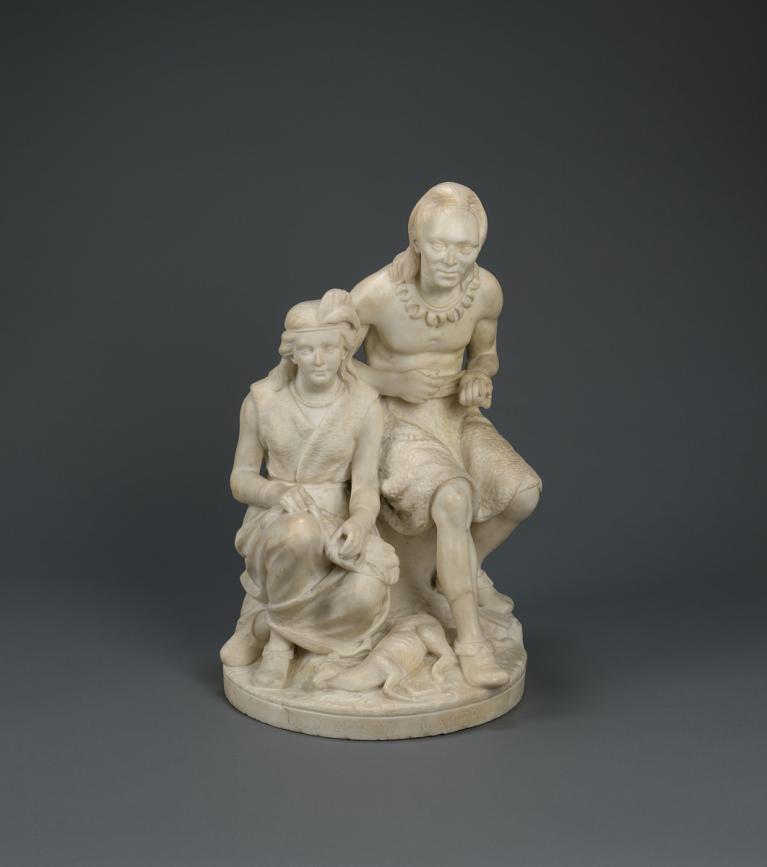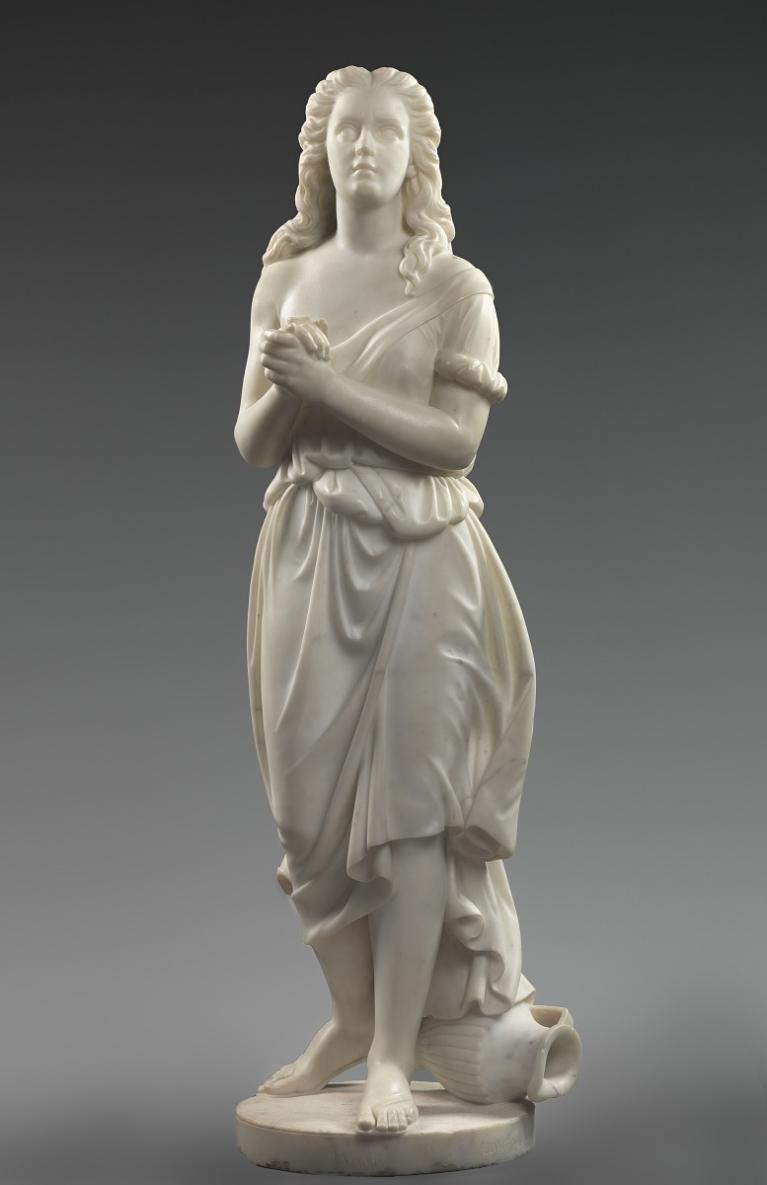Internationally acclaimed sculptor
Edmonia Lewis was one of the first Black and Indigenous sculptors to garner international acclaim. A pioneer for women of color in the fine arts, she is known for a style that combined neoclassicism with realism and naturalism, creating a body of work that defied easy categorization.
Mary Edmonia Lewis was likely born in 1844 near Albany, New York, though little reliable information about her early years is available. Her father, Samuel Lewis, was a free Black man who emigrated from the West Indies (most likely Haiti) and worked in domestic service. Lewis’s mother, who was Chippewa (Ojibwe) and African American, worked as an artist and sold Chippewa crafts to tourists. Both of Lewis’s parents passed away by the time she was five years old. After their deaths, she lived with her mother’s family near Niagara Falls, New York.
Lewis had an older brother, also named Samuel, who went to California during the Gold Rush and made a small fortune, which he used to provide for Lewis’s education. (It is unclear if Samuel was her half-brother or stepbrother.) She attended a school in Baltimore run by an order of Black nuns as well as coeducational high school in upstate New York, before enrolling in Ohio’s Oberlin College.
Oberlin was the first college in the United States to adopt a policy admitting Black students (1835) and the first to grant bachelor’s degrees to female students in a coeducational program (1841). However, these progressive policies did not mean that Oberlin was a welcoming place for a Black and Indigenous woman like Lewis. In 1862, two white students accused Lewis of attempting to poison them. The college investigated the accusation and Lewis was cleared of the charges due to a lack of evidence, but soon after she was attacked by a mob of white men who kidnapped her, brutally beat her, and left her for dead in the freezing cold. Lewis managed to survive, but she soon faced another baseless accusation (theft of art supplies) and left Oberlin.
In early 1863, Lewis moved to Boston to study sculpture. As a Black woman, she routinely faced exclusion while pursuing her art. For example, she was barred from the anatomy classes in which sculptors studied the human form, as they only admitted white men. Eventually sculptor Edward A. Brackett recognized Lewis’s talent and took her on as an apprentice. However, with the financial support of her brother, she soon opened her own studio.
Lewis’s art was championed by the abolitionist community in Boston. Prominent women such as Lydia Maria Child and Elizabeth Peabody helped her career by commissioning artworks. Lewis’s earliest works were busts and medallions that featured portraits of well-known abolitionists, including John Brown, William Lloyd Garrison, and Maria Weston Chapman. In 1864, Lewis sculpted a bust of Colonel Robert Shaw, the famous white Union officer who led the all-Black 54th Massachusetts Infantry Regiment. Shaw was killed when the regiment suffered heavy casualties during the Second Battle of Fort Wagner in July 1863. The bust became so popular among Bostonians that she was able to sell more than 100 plaster copies of the piece.
Lewis used the funds from her Shaw sculpture to help finance her 1865 trip to Europe. After traveling through England, France, and Italy, Lewis decided to remain permanently in Rome, where she opened her own studio. Years later, she told the New York Times how racism in the United States drove her to leave the country. Lewis said she was:
practically driven to Rome, in order to obtain the opportunities for art culture, and to find a social atmosphere where I was not constantly reminded of my color. The land of liberty had no room for a colored sculptor.
In Rome, Lewis joined a large artistic expatriate community that included notable female sculptors Anne Whitney, Harriet Hosmer, and Emma Stebbins. Lewis’s studio on the Piazza Barberini became a must-visit spot in Rome for sophisticated travelers touring Europe, such as Frederick Douglass. During this time, Lewis adopted a neoclassical style and began sculpting in marble.
Lewis’s sculptures continued to feature celebrated figures from the Civil War and the antislavery movement, but she also drew inspiration from the Bible, literature, mythology, and her Indigenous heritage. Lewis created more than 60 works in her career, though fewer than half are accounted for today. Her prominent pieces include Forever Free (1867), an enslaved couple reacting to Emancipation; Old Arrow Maker and His Daughter (1872), a father and daughter from the Dakota tribe; Hagar (1875), the biblical handmaiden; and The Death of Cleopatra (1876). The Death of Cleopatra was Lewis’s largest work and took more than four years to complete. Lewis displayed this career milestone at the Philadelphia Centennial Exhibition in 1876, where one reviewer called it “perhaps the most remarkable piece of sculpture in the American section.” After the exhibition, the piece was lost for more than a century before being recovered; today it sits in the Smithsonian American Art Museum.
In the 1880s, Lewis receded from public life. She died in London on September 17, 1907. Today, Lewis’s sculptures are held by a variety of prominent museums, including the Metropolitan Museum of Art, the Detroit Institute of the Arts, and the Howard University Art Gallery. Lewis’s legacy was doubly honored in 2022, when the U.S. Postal Service released an Edmonia Lewis postage stamp and Oberlin College awarded Lewis a posthumous diploma.
Additional Resources
Edmonia Lewis, Smithsonian American Art Museum
Bibliography
Boomer, Lee. “Life Story: Edmonia Lewis.” Women & the American Story (blog).
Cheng, Lucia. “After More Than 150 Years, Sculptor Edmonia Lewis Finally Gets Her Degree.” Smithsonian Magazine. July 20, 2022.
George, Alice. “Sculptor Edmonia Lewis Shattered Gender and Race Expectations in 19th-Century America.” Smithsonian Magazine. August 22, 2019.
Green, Penelope. “Overlooked No More: Edmonia Lewis, Sculptor of Worldwide Acclaim.” The New York Times. July 25, 2018.
Jones, Ashley. “Edmonia Lewis (1845-1907),” Black Past. April 15, 2008.
Moorhead, Joanna. “Feted, Forgotten, Redeemed: How Edmonia Lewis Made Her Mark.” The Observer, October 10, 2021, sec. Art and design.
Oberlin College and Conservatory. “Oberlin History.” February 23, 2017.
Rothberg, Emma. “Edmonia Lewis.” National Women’s History Museum. Written 2021, Updated 2024.
Zack, Aaron. “The 54th Massachusetts and the Second Battle of Fort Wagner (U.S. National Park Service).”



